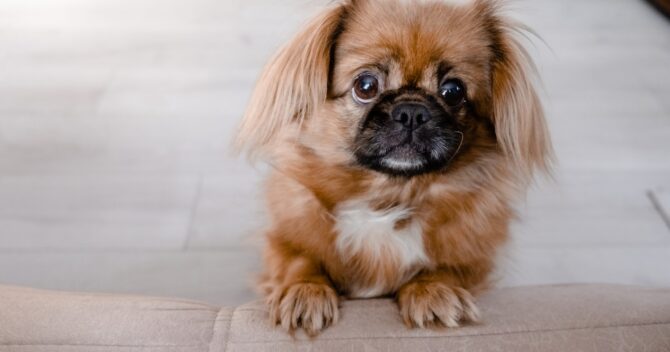Pekingese - energetic little lion
The Pekingese is a proud, elegant dog with an independent character. This dignified little lion values comfort and peace. He is a wonderful yet demanding companion.
The Pekingese is a proud, elegant dog with an independent character. This dignified little lion values comfort and peace. He is a wonderful yet demanding companion.

The Pekingese is a small dog with a lion appearance. According to the classification The FCI belongs to Group 9 - Companion and Toy Dogs, Section 8 - Japanese Chin and Pekingese. Its harmonious, squat silhouette fits into a rectangle, which means that the length from the withers to the base of the tail is greater than the height at the withers. It has a flat profile, wide set, large dark eyes, a wide muzzle with a strong mandible, a short wide nose and large and obtuse nostrils. His the neck is short and thick. Close to the head the auricles are set at the level of the skull. It has short torso with a pronounced waist, a the high set tail is slightly curved over the back to one side. The forelegs are short, strong and thick. while the hind legs are well muscled with moderate angulation of the knee joint. The weight of the dogs reaches 5 kg, and the bitches range from 3 to 5 kg. Males reach a height of 15-25 cm at the withers, while females 14-24 cm.
The Pekingese has long, straight hair. Its coat is made of a hard top coat and a thick, soft undercoat. It has longer feathers on the ears, hind legs, tail and toes, and the abundant mane that falls below the shoulder forms a ruff around the neck. It comes in many varieties of color, different types of markings are also allowed.
Here are the suggested sizes for adult dogs of this breed. They were selected on the basis of many years of experience in sewing accessories and the most common choices of other dog owners of this breed. Remember, only measuring will give you 100% certainty - every dog is different.
Among the diseases typical of this breed are:
It is worth remembering that breathing problems worsen in Pekingese on hot and rainy days. You should then give up tiring walks.
The Pekingese requires careful care, regular brushing and brushing, especially around the chest, sides and abdomen. Otherwise, the hair will feel felted and subsequent treatments will be simply painful for your pet. In addition, matted hair prevents the skin from breathing, and thus does not fulfill its function. It is especially important to wash the eyes regularly with special preparations, check the nostrils and clean (with a tissue) the nasal plate. The teeth that need to be cleaned on a regular basis also require attention to prevent premature loss. The Pekingese should not be bathed too often, in most cases it is enough to wipe the hair with a wet cloth, wipe the feet. For bathing (once every 4 months) it is worth using a good quality shampoo, intended for long-haired dogs. Remember to brush your pet only after the coat is dry.
Pekingese is a small dog with a firm, independent character. He can be stubborn, aggressive and impulsive. When he has no respect for someone, he ostentatiously ignores his instructions and acts haughty. In raising a dog of this breed, consistency, patience and understanding of his personality are important. Absolute obedience cannot be expected from him. However, it is worth setting limits and training in a friendly, wise and prudent way.
Pekingese likes peace, quiet and order. She does not tolerate noisy, energetic children, chaos and chaos. He likes being close to his household members, but also appreciates personal space. He keeps a distance from strangers, is distrustful and can even be belligerent. However, in relation to the guardian, he is faithful, loving and devoted. He loves caresses, although he decides when and to whom he allows it. You just deserve his affection.
He is brave when dealing with other dogs, he can also stand up for the owner. Although he likes walking, he is not suitable for long, tiring trips, increased physical activity or practicing dog sports. It is mainly related to the anatomical conditions of the body.
For an adult Pekingese, the daily servings (preferably two) should consist of the highest quality chopped food. The diet should include meat and additives such as rice, pasta, white cheese, cooked vegetables, fruit, nuts, and seed sprouts. From time to time, the menu can be spiced up with giblets, which are a source of calcium and contain a lot of iron. You should also remember to supplement with vitamins and minerals. Make sure your dog is fed at the same place and time.
The Cocker Spaniel is a cheerful, lively dog with boundless energy. It is perfect both as a hunter's assistant and a companion for children's games. With his cordiality and tenderness of his big, gentle eyes, he can melt every heart.
Dogs communicate with the environment through, inter alia, growling, panting, squeaking, howling and whining, but most often they communicate through various types of barking. When this natural behavior of a pet turns into a problem that is burdensome for the environment, you should be aware that ignoring this condition may have serious consequences. First of all, it will not improve the situation, but will only perpetuate the wrong reactions. It can also have an adverse effect on your pet's health. How to teach your dog to bark, the persistent one?
The English Bulldog, although sometimes appearing sluggish, is a resolute, strong and active dog. His athletic, awe-inspiring posture contrasts with his gentle disposition. He is joyful, sociable, caring and perfect as a family dog and companion.